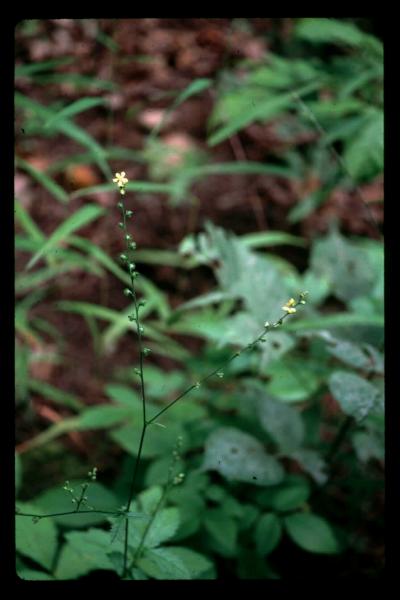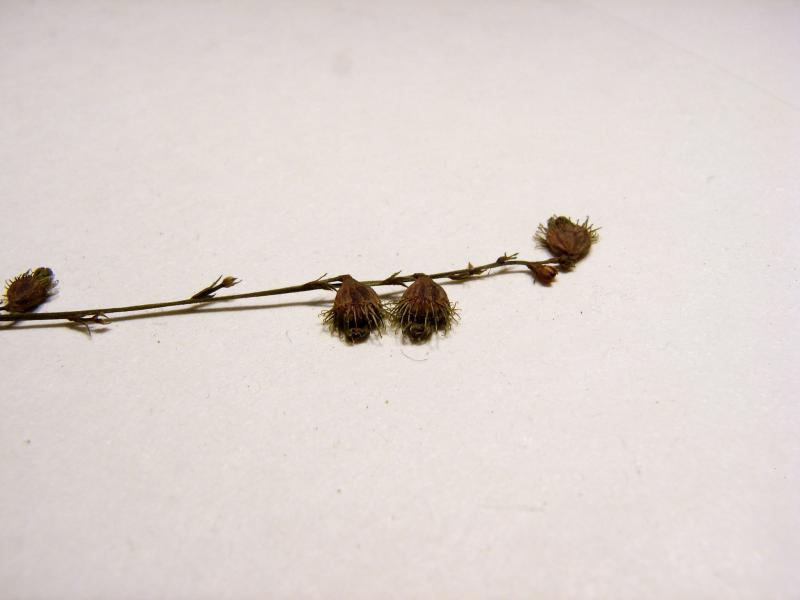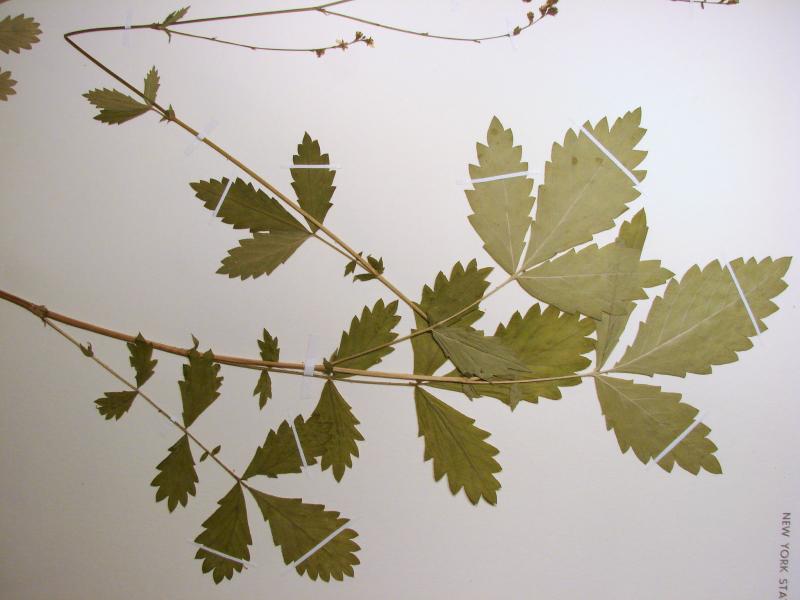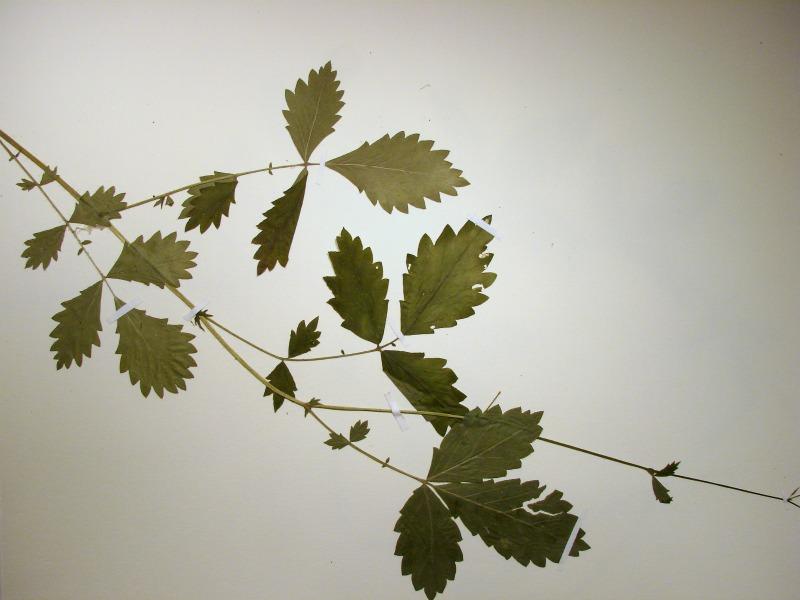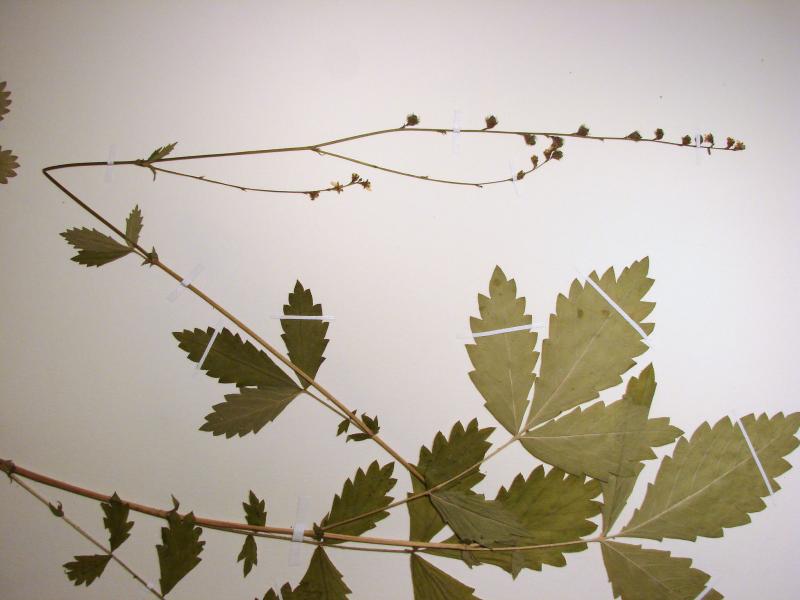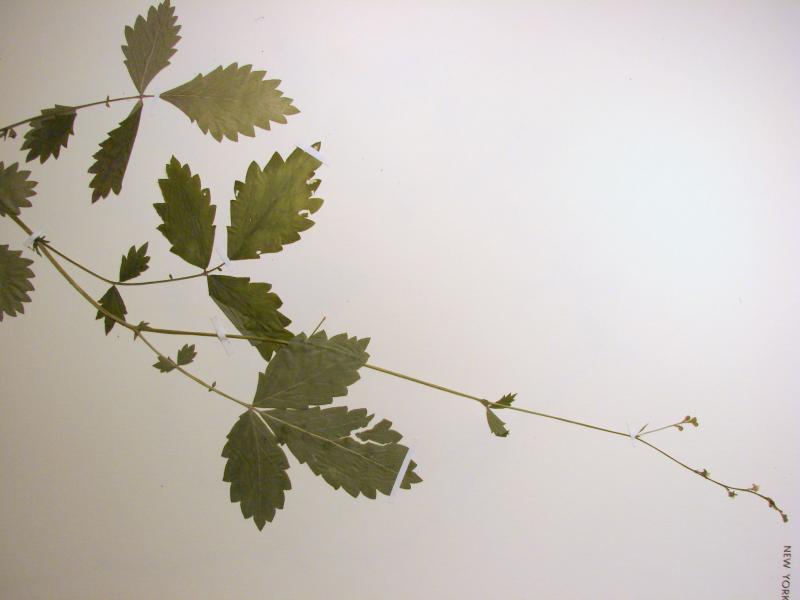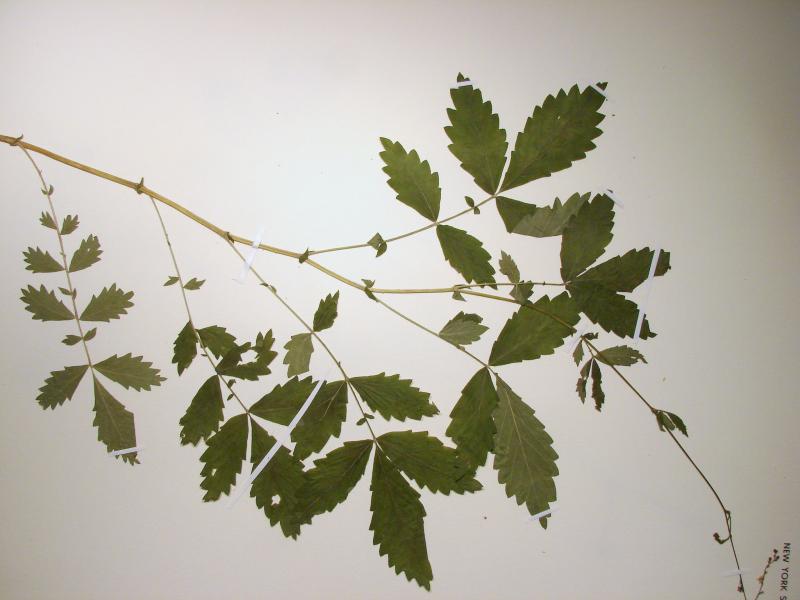Woodland Agrimony
Agrimonia rostellata Wallr.
- Class
- Dicotyledoneae (Dicots)
- Family
- Rosaceae (Rose Family)
- State Protection
- Threatened
Listed as Threatened by New York State: likely to become Endangered in the foreseeable future. For animals, taking, importation, transportation, or possession is prohibited, except under license or permit. For plants, removal or damage without the consent of the landowner is prohibited.
- Federal Protection
- Not Listed
- State Conservation Status Rank
- S2
Imperiled in New York - Very vulnerable to disappearing from New York due to rarity or other factors; typically 6 to 20 populations or locations in New York, very few individuals, very restricted range, few remaining acres (or miles of stream), and/or steep declines.
- Global Conservation Status Rank
- G5
Secure globally - Common in the world; widespread and abundant (but may be rare in some parts of its range).
Summary
Did you know?
Woodland agrimony is the smallest member of the Agrimonia genus in New York. The species name means "little beak" and refers to the small point on the top of the fruit formed by the mature sepals.
State Ranking Justification
There are currently 17 known populations in the state but almost all of the populations have less than 100 plants. There is only one large population of more than 10,000 plants. There are 16 historical populations, mostly from the lower Hudson Valley and Long Island, but many of them have become extirpated by development. Population trends seem to be stable and threats to known populations are low.
Short-term Trends
There have been very few follow-up surveys of the occurrences in the state but the few that have been done show no change in status.
Long-term Trends
The plant populations will probably be stable for the foreseeable future but more surveys are needed. Most populations occur in areas where habitat development is slow.
Conservation and Management
Threats
More research is needed before a full threats assessment can be addressed. At this time, the threats are presumed minimal. The main threats are probably habitat conversion due to logging, development, and succession. Deer browse and invasive species may present local threats to some populations.
Conservation Strategies and Management Practices
The woodland understory where this species occurs should be left undisturbed. A sufficient forest buffer should remain around populations to prevent the introduction of exotic species or a change in natural processes.
Research Needs
More specific information is needed about habitat preference for this species.
Habitat
Habitat
A plant of rich mesic forests, forested gorge slopes cutting through calcareous bedrock, streambanks in rich forests, forested slopes adjacent to streams, forested limestone benches, dry oak woods, wooded pastures on rich soil, shrub thickets, and other mesic sites that are typically wooded and on calcareous soils (New York Natural Heritage Program 2006). Woods, fields, and thickets (Rhoads and Block 2000). Moist rich woods (Gleason and Cronquist 1991). Oak-hickory woods, sandy clearings, and thickets (Voss 1985). Open woods (Fernald 1970).
Associated Ecological Communities
- Appalachian oak-hickory forest
(guide)
A hardwood forest that occurs on well-drained sites, usually on ridgetops, upper slopes, or south- and west-facing slopes. The soils are usually loams or sandy loams. This is a broadly defined forest community with several regional and edaphic variants. The dominant trees include red oak, white oak, and/or black oak. Mixed with the oaks, usually at lower densities, are pignut, shagbark, and/or sweet pignut hickory.
- Beech-maple mesic forest*
(guide)
A hardwood forest with sugar maple and American beech codominant. This is a broadly defined community type with several variants. These forests occur on moist, well-drained, usually acid soils. Common associates are yellow birch, white ash, hop hornbeam, and red maple.
- Hemlock-northern hardwood forest
(guide)
A mixed forest that typically occurs on middle to lower slopes of ravines, on cool, mid-elevation slopes, and on moist, well-drained sites at the margins of swamps. Eastern hemlock is present and is often the most abundant tree in the forest.
- Limestone woodland
(guide)
A woodland that occurs on shallow soils over limestone bedrock in non-alvar settings, and usually includes numerous rock outcrops. There are usually several codominant trees, although one species may become dominant in any one stand.
- Maple-basswood rich mesic forest
(guide)
A species rich hardwood forest that typically occurs on well-drained, moist soils of circumneutral pH. Rich herbs are predominant in the ground layer and are usually correlated with calcareous bedrock, although bedrock does not have to be exposed. The dominant trees are sugar maple, basswood, and white ash.
- Rich mesophytic forest*
(guide)
A hardwood or mixed forest that resembles the mixed mesophytic forests of the Allegheny Plateau south of New York but is less diverse. It occurs on rich, fine-textured, well-drained soils that are favorable for the dominance of a wide variety of tree species. A canopy with a relatively large number of codominant trees characterizes this forest. Canopy codominants include five or more of the following species: red oak, red maple, white ash, American beech, sugar maple, black cherry, cucumber tree, and black birch.
- Silver maple-ash swamp*
(guide)
A hardwood basin swamp that typically occurs in poorly-drained depressions or along the borders of large lakes, and less frequently in poorly drained soils along rivers. These sites are characterized by uniformly wet conditions with minimal seasonal fluctuations in water levels. The dominant trees are usually silver maple and green ash.
- Successional old field*
A meadow dominated by forbs and grasses that occurs on sites that have been cleared and plowed (for farming or development), and then abandoned or only occasionally mowed.
- Successional red cedar woodland*
A woodland community that commonly occurs on abandoned agricultural fields and pastures, usually at elevations less than 1000 ft (305 m). The dominant tree is eastern red cedar, which may occur widely spaced in young stands and may be rather dense in more mature stands.
- Successional shrubland*
A shrubland that occurs on sites that have been cleared (for farming, logging, development, etc.) or otherwise disturbed. This community has at least 50% cover of shrubs.
* probable association but not confirmed.
Associated Species
- Acer nigrum (black maple)
- Acer saccharum (sugar maple)
- Ageratina altissima var. altissima (common white snakeroot)
- Agrimonia gryposepala (common agrimony)
- Amphicarpaea bracteata (hog peanut)
- Asclepias quadrifolia (four-leaved milkweed)
- Brachyelytrum erectum (southern shorthusk)
- Carex pensylvanica (Pennsylvania sedge)
- Carex willdenowii (Willdenow's sedge)
- Carpinus caroliniana ssp. virginiana (musclewood, ironwood, American hornbeam)
- Carya glabra (pignut hickory)
- Desmodium glutinosum
- Dichanthelium boscii (Bosc's rosette grass)
- Elymus hystrix var. hystrix (bottle-brush grass)
- Fraxinus americana (white ash)
- Galium triflorum (sweet-scented bed-straw)
- Geranium maculatum (wild geranium)
- Ostrya virginiana (hop hornbeam, ironwood)
- Persicaria virginiana (jumpseed)
- Poa compressa (flat-stemmed blue grass, Canada blue grass)
- Podophyllum peltatum (may-apple)
- Quercus alba (white oak)
- Quercus rubra (northern red oak)
- Solidago caesia
- Tilia americana var. americana (American basswood)
Range
New York State Distribution
Typically a plant of calcareous regions, this plant ranges from Albany, west along the Niagara/Onondaga Escarpment, and south in Letchworth State Park, the Hudson Valley, and Long Island.
Global Distribution
This herbaceous plant ranges from Connecticut, New York, Michigan, and Minnesota, south to Texas and Florida.
Identification Comments
General Description
Woodland Agrimonia leaves grow on slender stems up to 3 feet tall but they are usually 2 feet tall or less. Each leaf contains 3-9 leaflets which are thin and oblong with large coarse teeth. They have conspicuous glands on the underside but are otherwise without hairs or with short hairs on the veins beneath. The flowering and fruiting stem has glands on the surface and sometimes also a few straight bristles. The bottom half of the bell-shaped fruit is about 1/4" long and covered with glands but not hairy. The roots are sometimes tuberous and thickened but not fibrous.
Identifying Characteristics
This slender plant with nearly glabrous stems grows up to one meter tall. The stems are up to 3 mm thick and the roots are sometimes tuberous-thickened. The 5-7 larger leaflets are elliptic to narrowly obovate, glabrous or with few hairs along the veins, and with small resinous glands beneath. There are 1-3 smaller leaflets between each pair of larger leaflets. The axis of the inflorescence is glandular. The yellow flowers are 4-5 mm wide and the floral tube 2-2.5 mm wide. The fruits are 3.5-9 mm long.
Best Life Stage for Proper Identification
The plant should be in flower or in fruit with leaves. To verify its identification, collect a voucher specimen that includes the entire plant (i.e. leaves, roots, flowers, and fruits).
Similar Species
Common agrimony (Agrimonia gryposepala) has glands and long speading hairs in the flowering axis. In addition, the stem in the common agrimony is up to 4 mm thick and the fruit has many more bristles.
Best Time to See
This plant begins to flower by late June and fruits are present from late July to early frost. This plant can be identified vegetatively, but ideally identifications use flower and fruit characteristics. As such, surveys are best conducted from early July to mid-September.
- Vegetative
- Flowering
- Fruiting
The time of year you would expect to find Woodland Agrimony vegetative, flowering, and fruiting in New York.
Woodland Agrimony Images
Taxonomy
Woodland Agrimony
Agrimonia rostellata Wallr.
- Kingdom Plantae
- Phylum Anthophyta
- Class Dicotyledoneae
(Dicots)
- Order Rosales
- Family Rosaceae (Rose Family)
- Order Rosales
- Class Dicotyledoneae
(Dicots)
- Phylum Anthophyta
Additional Common Names
- Agrimony
- Cocklebur
Additional Resources
Best Identification Reference
Voss, E.G. 1985. Michigan Flora. Part II. Dicots (Saururaceae - Cornaceae). Cranbrook Institute of Science and University of Michigan Herbarium. Ann Arbor, Michigan. 724 pp.
Other References
Fernald, M.L. 1950. Gray's manual of botany. 8th edition. D. Van Nostrand, New York. 1632 pp.
Gleason, Henry A. and A. Cronquist. 1991. Manual of Vascular Plants of Northeastern United States and Adjacent Canada. The New York Botanical Garden, Bronx, New York. 910 pp.
Holmgren, Noel. 1998. The Illustrated Companion to Gleason and Cronquist's Manual. Illustrations of the Vascular Plants of Northeastern United States and Adjacent Canada. The New York Botanical Garden, Bronx, New York.
Mitchell, Richard S. and Gordon C. Tucker. 1997. Revised Checklist of New York State Plants. Contributions to a Flora of New York State. Checklist IV. Bulletin No. 490. New York State Museum. Albany, NY. 400 pp.
New York Natural Heritage Program. 2010. Biotics database. New York Natural Heritage Program. New York State Department of Environmental Conservation. Albany, NY.
New York Natural Heritage Program. 2024. New York Natural Heritage Program Databases. Albany, NY.
Newcomb, Lawrence. 1977. Newcomb's Wildflower Guide: An Ingenious New Key System for Quick, Positive Field Identification of the Wildflowers, Flowering Shrubs, and Vines of Northeastern and North-Central North America. Little, Brown and Company. Boston.
Rhoads, Ann F. and Timothy A. Block. 2000. The Plants of Pennsylvania, an Illustrated Manual. University of Pennsylvania Press, Philadelphia, PA.
Weldy, T. and D. Werier. 2010. New York flora atlas. [S.M. Landry, K.N. Campbell, and L.D. Mabe (original application development), Florida Center for Community Design and Research http://www.fccdr.usf.edu/. University of South Florida http://www.usf.edu/]. New York Flora Association http://newyork.plantatlas.usf.edu/, Albany, New York
Weldy, Troy W. and David Werier. 2005. New York Flora Atlas. [S.M. Landry, K.N. Campbell, and L.D. Mabe (original application development), Florida Center for Community Design and Research. University of South Florida]. New York Flora Association, Albany, NY. Available on the web at (http://newyork.plantatlas.usf.edu/).
Links
About This Guide
Information for this guide was last updated on: January 12, 2009
Please cite this page as:
New York Natural Heritage Program. 2024.
Online Conservation Guide for
Agrimonia rostellata.
Available from: https://guides.nynhp.org/woodland-agrimony/.
Accessed July 26, 2024.

